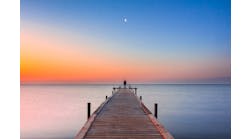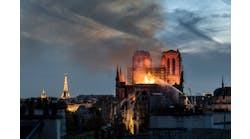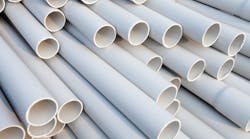Latest from Yates
Sponsored
Should PVC schedule 40 pipe and fittings continue to be permitted for combustion exhaust venting? You and I have come across PVC that has gone from white to many colored shades: from light yellow to tan to almost looking like ABS black. We all know that is due to overheating and you, like me, have probably seen deformation from overheating. In some cases, it’s due to PVC having been used for combustion venting for standard (chimney-vented, or should have been!) water heaters, 80% efficiency boilers or furnaces, and other flagrant violations of codes. No, I’m talking here about “proper” PVC combustion venting applications that are manufacturer approved. What can, and does, really frighten me is seeing foam-core PVC utilized for combustion venting for boilers and water heaters.
What’s up with furnaces using PVC? I don’t see the same change in weird colors as I do with boilers. High-efficiency furnaces see relatively steady-state conditions with return-air around 68°F and supply-air around 120°F – providing the ductwork was properly sized, allowing full flow across the heat exchanger. You can safely assume a 20°F (average) increase in the exhaust vent over the supply air temp, which keeps the PVC well within its safe range for maximum temperature limits.
Boilers, on the other hand, have a far different operating range with an upper limit of 205°F for modcons. In more than a few cases where the PVC was an odd color, outdoor reset had never been utilized and the installer had set the modcon to run up to its maximum temperature limit! 205°F + 20°F = 225°F. What is the safe operating range for PVC in venting applications? I reached out to Brian Fenske at Navien for help:
Many anti-PVC venting advocates have continued to argue the piping standards regarding PVC pipe used as venting systems referencing plumbing standards.
ASTM Standard, ASTM D1785 standard applicable to PVC plastic pipe and fittings includes the following note: "This standard specification for PVC pipe does not include requirements for pipe and fittings intended to be used to vent combustion gases". D 1785 is the specification for Poly Vinyl Chloride (PVC) plastic pipe, schedule 40, 80 and 120. The scope of this specification covers PVC pipe in Sch. 40, 80 & 120 for pressure applications where the operating temperature will not exceed 140-degree Fahrenheit. This scope is where many misunderstand the application and requirements of PVC in an appliance venting situation. The use of acceptable PVC pipe for venting of gas-fired appliances in accordance to manufacturers installation and operation manuals are never subjected to measurable pressures. Pressure applications do not occur in an appliance gas-fired combustion venting system thus, D1785 plumbing standard, 140°F limitations does not apply.
According to PVC Pipe and fitting manufacturers, schedule 40 PVC DWV has the following ratings:
Maximum Temperature: 158°F, 70°C
Minimum Temperature: -13°F, -25°C
Melting Point: 176°F, 80°C
Tensile Strength: 6,500 psi
The 149°F melting and breakdown of Sch 40 PVC continues to be tossed out there as a limit when it is false. This temp concern is derived from the temperature pressure charts of PVC in water use applications under a minimal pressure of 20 PSI. Appliance venting is not under any measurable pressure. The real limitation is 158°F, and we as manufacturers limit and control our appliances at 150°F through internal safeties.
The answer I was looking for: the actual limitation is 158°F for maximum sustained exhaust limitation. In theory then, boiler water temperatures above 138°F will result in exhaust temperatures that will exceed 158°F. No wonder we see discoloration in PVC exhaust vent piping.
There already are places in the USA where PVC can not be used for combustion venting: New York City and Las Vegas will not allow any plastic combustion venting in commercial applications. What about Canada? I’d head they placed restrictions on using PVC. Fenske had this to say:
It’s not officially banned as a product in Canada just has a required approval and this continues to confuse the industry. Especially those that live outside of Canada. In Canada they use a standard CSA B149.1 Natural Gas and Propane Installation Code which requires all special venting material to be certified to ULC S636.
Is there an alternative that can handle the higher-than-158°F exhaust gas temperatures? Absolutely: Polypropylene.
Essentially what that means is System 636 has two distinct materials (PVC & CPVC), each with a unique temperature rating. These venting systems are approved as Type BH vents and are designed for negative or positive pressure venting of gas-fired appliances. This is the same PVC and CPVC that we use but is approved as a system.
Aren’t water heaters therefore safe? After all, they arrive from the factory set for 120°F, so given the 20°F increase in stack temperature; they are well under the 158°F noted, right? When new, yes, but scale can inhibit heat transfer, which can cause the stack exhaust temperature to rise well above 158°F.
I turned to another trusted mentor: Steve, “Wheels” Wieland who is with NTI Boilers.
I have seen PVC in all colors:
White
Yellow
Tan
Brown
Pink
Purple
Black
GONE
In my territory PVC is outlawed in all 5 boroughs of NY City. http://www.nyc.gov/html/dob/apps/pdf_viewer/viewer.html?file=2014CC_FGC_Chapter5_Chimneys_and_Vents.pdf§ion=conscode_2014
I am under the impression that the National code now reads (or will) that PVC cannot be used if supply temps exceed 140°F
We also discussed other issues and Wheels noted there is some discussion regarding UV degradation that might lead to odd colors in PVC. Think of all the PVC cleanout risers (for those who can't cut them flush with grade) and fresh air vents that are 100% exposed to UV and have been for decades! Still white? In addition, I’m not seeing a visible color difference between interior PVC combustion piping vs. the exterior counterpart. Not to mention the millions of PVC plumbing vents poking out of rooftops all across the US and around the world. They're all still white, so riddle me that Batman. Maybe we just need to rub SPF-50 on the PVC combustion vents?
Is there an alternative that can handle the higher-than-158°F exhaust gas temperatures? Absolutely: Polypropylene, which can handle a sustained flue gas temperature of 230°F. Lightweight, easy to handle, and fast installation time makes this more-expensive-than-PVC product not only competitive by reducing labor, but reduces your liability too.
We have used Centrotherm (http://www.centrotherm.us.com/Home.aspx) PP flue piping and chimney liners on multiple occasions for modcons, combi boilers, and high efficiency tankless water heaters. Knowing any one of those appliances has the potential to exceed 158°F flue gas temperatures, it makes perfect sense to use PP for combustion venting.
For more information, Google polypropylene vent pipe manufacturers and check with your local wholesalers to find out which products they stock.
Dave Yates material both in print and online is protected by Copyright 2018. Any reuse of this material (print or electronic) must have the express written permission of Dave Yates and CONTRACTOR magazine. Please contact via email at [email protected].
Dave Yates
Dave Yates material in print and on Contractor’s Website is protected by Copyright 2017. Any reuse of this material (print or electronic) must first have the expressed written permission of Dave Yates and Contractor magazine.


